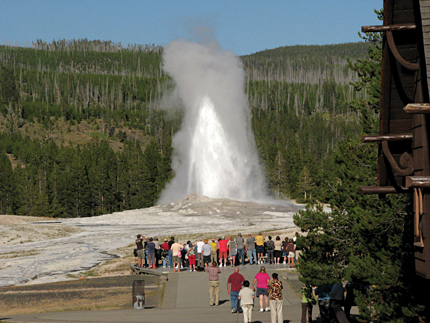
Old Faithful geyser, viewed from the porch at the historic Old Faithful Inn.
Photo by: Andrew Collins
By: Andrew Collins*/Special for TRT–
Yellowstone, Cody, Bozeman, and Jackson Hole
Established as America’s first national park in 1872, Yellowstone has bewitched human visitors for more than 11,000 years with its otherworldly landscape of geothermal features, coniferous forest, and high-altitude lakes and rivers. It’s one of the most visited places in North America, and this immense park is accessed on all sides by communities that command plenty of attention in their own rights – rugged western mountain towns like Bozeman, Cody, and Jackson. A trip to Yellowstone can easily be an adventure of a lifetime.
Although you won’t find an obvious gay scene in the region, in this part of the West, you’ll encounter a welcoming and generally tolerant live-and-let-live spirit, where locals tend to care more about whether their neighbors are reliable and honest than if they’re gay or straight. Bozeman and Jackson are among the most politically liberal towns in their respective states, and Cody is home to one of the few vocal proponents of gay rights in the Republican Party, former U.S. Sen. Alan Simpson. The town also hosts a fabulous Western fashion-themed fundraiser each September, the Rendezvous Royale (rendezvousroyale.org), whose efforts support the town’s outstanding Buffalo Bill Historical Center museum complex.
Furthermore, the U.S. National Park Service takes great pride in the diversity of its workforce and contributions by its LGBT employees (www.nps.gov/diversity/lgbt.htm), and its lodging concessions in Yellowstone (Xanterra Parks & Resorts) and Grand Teton (Grand Teton Lodge Company) are enthusiastically gay-friendly.
Planning a Trip to the Yellowstone Region
There’s enough to see and do within Yellowstone’s park boundary, which at 3,472 square miles is approximately the size of Delaware and Rhode Island combined, to keep you entertained for a full week. If you’re coming a long way to visit the park, you should try to spend at least four days here, and allow an extra two to three days if visiting any of the major park gateway communities, such as Bozeman, Cody, and Jackson (where you may want to spend a day or two in Grand Teton National Park). Trying to visit the region over a two- or three-day weekend is technically possible but very restrictive, and you’re likely to find yourself rushed and wishing you had more time.
Yellowstone National Park has five entrances, most open spring through fall and others (on the north and west sides) open year-round. The most popular regional airports are in Bozeman, Montana; Cody, Wyoming; and Jackson, Wyoming; there’s also more limited, seasonal service on Delta to West Yellowstone, Montana. The closest major city is Salt Lake, Utah, about 370 miles south.
Yellowstone National Park
Few sites in the world inspire a more stirring reaction in visitors than Yellowstone National Park (www.nps.gov/yell), a literal hotbed of volcanic and geothermal activity set around a humungous collapsed caldera and constantly moving and shaking with tremors, bubbling hot springs, and gaseous fumaroles. Nowhere on the planet can you view so many geysers, but while these sites are arguably the park’s most famous collective feature, Yellowstone is a vast and diverse land.
Fans of wildlife can view the largest free-roaming herd of bison (buffalo) in the country, and opportunities also abound for viewing grizzly and black bears, elk, pronghorn, bighorn sheep, osprey, and countless other creatures in the wild. Rippling blue Lake Yellowstone, the largest freshwater lake in North America with an elevation above 7,000 feet, is home to 11 different native fish species. The lake is fed by the Yellowstone River, where you can see the powerful Upper and Lower waterfalls. The awe-inspiring Grand Canyon of Yellowstone is 24 miles long and ranges from 800 to 1,200 feet deep. More than 1,000 miles of hiking trails cover the park, much of which is blanketed by verdant lodgepole-pine forest. You’ll also find endless views of alpine meadows and cloud-scraping mountain peaks – the highest point, Eagle Peak, rises to 11,358 feet. Yellowstone is about much more than geysers.
Given the enormity of the park, it’s not surprising that Yellowstone has a rich variety of lodging options, each with its own distinct setting and character. You can book through Yellowstone National Park Lodges (www.yellowstonenationalparklodges.com). The most famous and historic properties – such as the Old Faithful Inn, Lake Yellowstone Hotel, and Mammoth Hot Springs Hotel – tend to book up months in advance; it’s a good idea to reserve as early as possible. It’s both practical and fun to stay in two or three different areas in the park over the course of several days. Yellowstone Lake, Old Faithful, Mammoth Hot Springs, and Canyon Village all make excellent bases and offer a good variety of accommodations, some of them quite affordable. Yellowstone’s hotel restaurants have undergone major improvements over the past few years – the Lake Yellowstone Hotel and Old Faithful Inn dining rooms are particularly well-recommended.
Bozeman, Montana
The laid-back college town of Bozeman (www.bozemancvb.com) makes a good base for visiting Yellowstone from the north. It’s about a 90-minute drive from the North Entrance (open year-round) of Yellowstone, near Mammoth Hot Springs, and a two-hour drive from the West Entrance (open late April to early November). This small city of about 38,000 is home to the superb Museum of the Rockies, which contains some of the world’s most important dinosaur remains, and it’s also a year-round hub for myriad recreational activities, including skiing in winter at nearby Bridger Bowl and Big Sky ski areas.
In downtown Bozeman you’ll find some terrific microbreweries and eateries, with Montana Ale Works, Over the Tapas, and Cateye Cafe leading the pack. The high quality of life and relatively progressive politics make it increasingly popular as a place to relocate, or spend summers, among gays and lesbians. Among accommodations, one of the finest B&Bs in town is the eight-room, gay-owned Lehrkind Mansion (www.bozemanbedandbreakfast.com), a splendid redbrick Victorian with an adjacent guest house. Other excellent, gay-friendly options in the area include the Silver Forest Inn (www.silverforestinn.com), which is up near Bridger Bowl ski area, and the posh Gallatin River Lodge (www.grlodge.com), a perfect perch for fly-fishing with a superb restaurant to match its cushy accommodations.
Cody, Wyoming
The rugged town of Cody (www.codychamber.org), named for the legendary Western showman Buffalo Bill Cody, is just 60 miles east of Yellowstone’s East Entrance (open early May through early November). This atmospheric, friendly community is known for its exceptional Buffalo Bill Historical Center, which consists of five different and beautifully laid out museums that focus on everything from Western art to the natural history of the Yellowstone region to antique firearms to the earliest indigenous residents of the Plains. Other notable draws are the Heart Mountain Interpretive Learning Center, about 15 miles east of Cody, which occupies a former World War II-era Japanese internment center and is filled with fascinated exhibits that tell the tragic story of this regrettable period in U.S. history; and the Cody Nite Rodeo, a rollicking rodeo that takes place each summer evening.
Cody’s historic downtown is an engaging spot for a stroll. You’ll find several galleries and shops selling beautiful hand-crafted Western furniture, and festive, down-home restaurants like the Hotel Irma, Silver Dollar Bar, and Wyoming Rib & Chop House are good bets for tasty, stick-to-your-ribs cooking. Cody has some terrific places to stay, including the smartly furnished and historic Chamberlin Inn (www.chamberlininn.com), an upscale boutique hotel in the center of town; and the contemporary Best Western Premier Ivy Inn & Suites (book.bestwestern.com), whose accommodations are among the most spacious and well-equipped in town.
If flying in and out of Cody for your Yellowstone visit, consider driving to the park via U.S. 20 through the East Entrance (the more direct route), and then returning to Cody via the Northeast Entrance (open late May through mid-October), at Cooke City, Montana. Follow U.S. 212 east over the spectacular Beartooth Pass (elevation 10,947 feet), stopping in the charming Old West town of Red Lodge, Montana (www.redlodge.com), and then continuing south to Cody – the total drive takes about 2.5 hours without stops.
Jackson and Grand Teton, Wyoming
Follow U.S. 89 out of Yellowstone’s South Entrance (open mid-May to early November) and you’ll immediately enter Grand Teton National Park (www.nps.gov/grte), famed for its soaring, jagged mountain peaks and pristine alpine lakes. The road then continues through the scenic Jackson Hole Valley to the down-home, cowboy-chic town of Jackson (www.jacksonholechamber.com), which like Bozeman is ideal for fly-fishing, mountain biking, horseback, and hiking in summer, and down-hill skiing in winter. It’s an increasingly swank town with some of the most opulent hotels in the Rockies, yet Jackson is both easy-going and friendly. It’s also in the only county in the state that has voted Democrat in the past few presidential elections (ironic, given that Dick Cheney has a home here).
The ski area, Jackson Hole Mountain Resort, actually lies 12 miles northwest of the bustling town of Jackson. The resort is surrounded by Teton Village, an attractive cluster of resorts, restaurants, and condos. Among Teton Village accommodations, consider the cushy Snake River Lodge & Spa (www.snakeriverlodge.rockresorts.com), an inviting hotel that’s home to one of the region’s top restaurants, GameFish, as well as the magnificent Avanyu Spa. Grand Teton National Park has several lodging options, with the famed Jackson Lake Lodge (www.gtlc.com), with its stunning views of Jackson Lake, a favorite.
In the town of Jackson itself, you’ll find a number of great restaurants, plus a good many spots to buy everything from high-end cowboy wear to top-of-the-line outdoor gear. Restaurants like Trio American Bistro and Wild Sage present an inventive version of regional Western cuisine. The latter restaurant is inside the renowned Rusty Parrot Lodge (www.rustyparrot.com), which sounds like the name of a kitschy motel but is, in fact, a rustic-elegant 30-room boutique hotel with a fine spa and richly appointed rooms. Less pricey but still excellent options in town include the log-cabin-style Elk County Inn (www.townsquareinns.com/elk-country) and the charmingly situated Spring Creek Ranch (www.springcreekranch.com), a gay-friendly condo resort with panoramic views of the Teton Range.
*Andrew Collins covers gay travel for the New York Times-owned website GayTravel.About.com and is the author of Fodor’s Gay Guide to the USA. He can be reached care of this publication or at OutofTown@qsyndicate.com.







